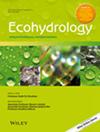Experimental Insights Into the Hydraulic Behaviour of Sinuous Channel due to Vegetated Floodplain Corridor
Abstract
Flow and turbulent characteristics were analysed at an experimental scale for four different floodplain vegetation layouts (leafy, grass, cylindrical and mixed vegetation) of a sinuous channel at submerged conditions. The results indicate that the velocity variations closely followed the logarithmic law for the no floodplain vegetation scenario and deviated from the logarithmic behaviour with changing floodplain vegetation. The average streamwise velocity for leafy vegetation is about 1.2 times that observed for the cylindrical vegetation due to changes in vegetation canopy porosity. Further, the transverse variability in velocity distribution from the inner bank to the outer bank is observed to be significant with changing floodplain vegetation. The turbulence intensities also indicate that the supplemental surface area of the fronds impacts the momentum transfer near the floodplain–main channel interface. It is observed that the changes in plant form morphology influenced the mean velocity within the main channel relative to the nonvegetated condition. Furthermore, the vertical components of the turbulence intensity increase from the bottom of the channel and reach the highest magnitude at the top of the water surface. This shows the transfer of energy closer to the surface in the vertical flow direction. The results indicate that altered flow pass affects the flow velocities at the transition zone. The findings from the present study on heterogeneous plant forms influence on flow characteristics may be helpful in river restoration practices for ecological management and river corridor stability.

 求助内容:
求助内容: 应助结果提醒方式:
应助结果提醒方式:


